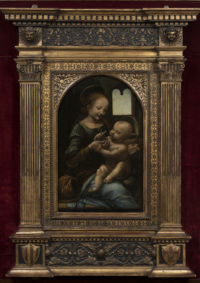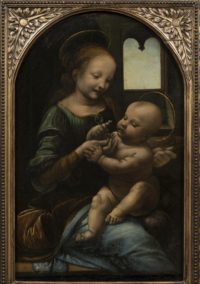 Leonardo da Vinci’s Madonna and Child with Flowers, also known as the Benois Madonna, is back in Italy for the first time in 35 years. On loan from the Hermitage Museum in St. Petersburg to commemorate the 500th anniversary of Leonardo’s death, it is at the Pinacoteca Comunale di Fabriano in Le Marche until June 30th and will be on display at the National Gallery of Umbria in Perugia from July 4th through August 4th.
Leonardo da Vinci’s Madonna and Child with Flowers, also known as the Benois Madonna, is back in Italy for the first time in 35 years. On loan from the Hermitage Museum in St. Petersburg to commemorate the 500th anniversary of Leonardo’s death, it is at the Pinacoteca Comunale di Fabriano in Le Marche until June 30th and will be on display at the National Gallery of Umbria in Perugia from July 4th through August 4th.
Created between 1478 and 1480 when the artist was in his mid-20s, the painting is believed to be Leonardo’s first work fully independent of his master Andrea del Verrocchio. Leonardo had worked in Verocchio’s studio from the time he was 14 years old, starting out as a shop errand boy and working his way up to a full apprenticeship. Even though he received his qualification as a master from the artists’ guild in 1472 and opened his own studio shortly thereafter, Leonardo continued to collaborate with Verrocchio for years, creating works very much in his former master’s style.
With Madonna and Child with Flowers, Leonardo embraced a new style and eschewing the previous generation’s formal representations of the Mother of God as the serene Queen of Heaven, introduced Mary as a young mother at home playing with her baby. The warm, palpable love between them is a different kind of allegory, a highly relatable view of the bond of spiritual motherhood captured in one sweet moment. This was Leonardo coming into his own, investing a scene from daily life with the profundity and symbolism of genre painting. The little flower, for example, that Mary holds in her fingers while the infant Christ grabs at it, is a premonitory symbol of the Crucifixion.
 The composition of happy mother, baby on her lap holding a flower, was immediately popular and preeminent artists of the era created their own versions. As famous as it was, the Madonna was lost for centuries. It wasn’t seen again in public until 1909 when it was exhibited by Russian architect Leon Benois. It had apparently left Italy in the 1790s, acquired by statesman and artillery general Alexey Ivanovich Korsakov who brought it to Russia. After his death in 1821, his son Nikolai tried to sell it at auction but failed to get the price he was hoping to get. Astrakhan merchant and art collector Aleksandr Petrovic Sapozhnikov waited patiently in the wings and finally got his mitts on it between 1823 and 1824.
The composition of happy mother, baby on her lap holding a flower, was immediately popular and preeminent artists of the era created their own versions. As famous as it was, the Madonna was lost for centuries. It wasn’t seen again in public until 1909 when it was exhibited by Russian architect Leon Benois. It had apparently left Italy in the 1790s, acquired by statesman and artillery general Alexey Ivanovich Korsakov who brought it to Russia. After his death in 1821, his son Nikolai tried to sell it at auction but failed to get the price he was hoping to get. Astrakhan merchant and art collector Aleksandr Petrovic Sapozhnikov waited patiently in the wings and finally got his mitts on it between 1823 and 1824.
Sapozhnikov had it removed from its original wood panel due its age and poor condition and transferred onto canvas. During the transfer process, an ink underdrawing was revealed. Sapozhnikov’s records indicate he never doubted its authorship, but the art historical community took a while to catch up. Its attribution was confirmed by the top authority in 1908 and since then the Benois Madonna has become firmly ensconced on the very, very short list of undisputed works by Leonardo.
It was acquired by the Hermitage Museum in 1914. Marija Aleksandrovna Sapožnikova Benois, Aleksandr Petrovic Sapozhnikov’s granddaughter and Leon’s wife, agreed they would sell it at a marked discount as long as the Hermitage agreed that it would always remain in Russia. The Hermitage only loans it out for very short trips very rarely.